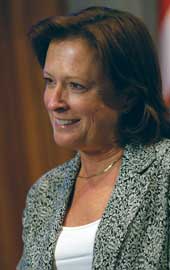Be prepared

Q&A | Most emergency alert opportunities will lie with the states, FEMA's Martha Rainville says.
The 2007 hurricane season has been relativelymild so far. But it is still a busy period forMartha Rainville in her new position overseeingnational public warnings and alerts at theFederal Emergency Management Agency.She joined FEMA in April as deputyadministrator of continuity programs.Rainville's responsibilities include FEMA'sIntegrated Public Alert and WarningSystem (IPAWS). It will expand the nation'slongstanding emergency alert system. Thegoal is to fulfill an executive order thatPresident Bush issued in June 2006 to builda comprehensive national warning systemthat transmits voice, video and text alerts toall media, including telephones, computersand cell phones.Two weeks ago, Rainville visited Mobile,Ala., with Homeland Security SecretaryMichael Chertoff to kick off a Gulf Coaststate demonstration of IPAWS that will runthrough the end of December. They urgedthe public to sign up for the voluntary optinportion of the system in which they willreceive alerts directly on their cell phonesand e-mail accounts."We have already signed up several thousandpeople in Mississippi," Rainville said."We are getting some strong feedback."In the pilot project, FEMA and SandiaNational Laboratory will deploy a Web alertand relay network that offers collaborationtools and access to Web sites. The systemincludes an emergency telephone notificationservice with automated telephone callsdelivering messages to all residents inaffected geographic areas. Both are componentsof IPAWS.Rainville, 49, is no stranger to theHurricane Belt. She spent much of her childhood in Port Gibson, Miss., and received her bachelor's degree from the University ofMississippi in 1979. She joined the Air Force,specializing in aircraft maintenance. Aftermoving to Vermont in 1988, she rose throughthe ranks to become the nation's first femaleState Adjutant General of the NationalGuard in 1997. She retired from the militaryafter 27 years of service last year. In the 2006elections, she was the Republican candidatefor a Vermont congressional seat, losing toDemocrat Peter Welch.She recently spoke with Staff Writer AliceLipowicz about IPAWS. IPAWS is a prettylarge part of the portfolio. It isone of the more public thingswe do, and it is a high priorityfor us. The opt-in portion of IPAWS isvoluntary; you must register in advance.The emergency telephone notification systempushes calls out to all phones. Thetechnology can make 60,000 calls in 10minutes. What we are finding is that thereare some restrictions in the infrastructure? in the capacity of the telephone lines tohandle all the calls. We are trying to findout what those constraints are. So far, wehave not seen any throttling of calls or collapsesin the system. After we finish the pilot project atthe end of December, if the testing goes asplanned, our goal is to offer the states a packageof capabilities as well as vendors who cancomply with the standards and protocols weare developing. The package will include theopt-in capabilities to send messages to cellphones and other devices; the emergencytelephone notification [system]; and warningservices for the deaf and hard of hearing,and in foreign languages. In the pilot phase,the governors are asking for Spanish andVietnamese as second and third languages.FEMA, the [Federal CommunicationsCommission] and [National Oceanic andAtmospheric Administration] are developingdifferent components. The system willuse the Common Alerting Protocol and theEmergency Data Exchange Language, [bothExtensible Markup Language formats].We changed tactics for IPAWS. We refocusedto provide enhanced capability for the2007 hurricane season. The packaging ofcapabilities will be useful to the states. We will have standards, andthrough Sandia Lab, we will be able to certifywhich vendors meet the standards. Statescan choose their own vendors. We have a budget of$75 million through 2007 underthe Stafford Act. There is $26.5 millionin the fiscal 2008 budget fordevelopment and testing.We are talking to the statesabout their needs, and we plan touse DHS grants to supply a portionof the funding. It is premature to say whatthat will be. This is optional for the states. I have a lot of confidence in thecapability and in the commitment thatFEMA has to field and test the capability. Itis the right thing to do and states need this.

WT: You have responsibility for
IPAWS and FEMA's federal continuity-
of-government and continuity-
of-operations activities.
How do those fit together?
Rainville:
WT: What are the lessons learned so far
from the IPAWS pilot project in the states
affected by hurricanes?
Rainville:
WT: What is FEMA's plan for implementing IPAWS nationwide?
Rainville:
WT: Will this be open-source or proprietary
technology? Sandia has selected several
subcontractors for the IPAWS pilot,
including MyStateUSA, NuParadigm
Foundation and Warning Systems Inc.
Rainville:
WT: How much is IPAWS costing this year,
and what is the total budget for IPAWS?
Who will pay the bulk of the
expense to implement it?
Rainville:
WT: How confident are you that FEMA
and the states will successfully deploy the
IPAWS capabilities?
Rainville:
Staff Writer Alice Lipowicz can be reached at alipowicz@1105govinfo.com.

Martha Rainville
Stan Barouh
WT: You have responsibility for
IPAWS and FEMA's federal continuity-
of-government and continuity-
of-operations activities.
How do those fit together?
Rainville:
WT: What are the lessons learned so far
from the IPAWS pilot project in the states
affected by hurricanes?
Rainville:
WT: What is FEMA's plan for implementing IPAWS nationwide?
Rainville:
"We are talking to the states about their needs,
and we plan to use DHS grants to supply a portion of the funding. It is premature to say what that will be." ? Martha Rainville, Federal Emergency Management Agency
WT: Will this be open-source or proprietary
technology? Sandia has selected several
subcontractors for the IPAWS pilot,
including MyStateUSA, NuParadigm
Foundation and Warning Systems Inc.
Rainville:
WT: How much is IPAWS costing this year,
and what is the total budget for IPAWS?
Who will pay the bulk of the
expense to implement it?
Rainville:
WT: How confident are you that FEMA
and the states will successfully deploy the
IPAWS capabilities?
Rainville:
Staff Writer Alice Lipowicz can be reached at alipowicz@1105govinfo.com.
NEXT STORY: 2007 Small Business Report | Diverse talents

